by: Tim Carter, W3ATB
(C)Copyright 2013 Tim Carter
All Rights Reserved
Author’s Note: April 16, 2023 – It’s come to my attention via an email from one of my newsletter subscribers that ALL of us were most likely pranked on April 16, 2013. There is clear undeniable evidence that the Boston Marathon bombing was a mass-training exercise with professional crisis actors using Hollywood-style pyrotechnical devices. These fake bombs used in movies and TV shows are for the most part harmless because the blast can be aimed in a direction other than where the actors are.
You should watch this video then watch this second one and digest what you see. If, in fact, we were pranked by our government, do you wonder why the media went along with it and didn’t push back with hard-hitting investigative reporting? Early on some reporters were asking questions about why odd things were happening just before the bombs went off but these were ignored by authorities giving the press conferences.
Who were the injured people? Were their names ever shared in the news as happens in other stories? Who knows any of the three people reported killed that day? Where are their graves? Has anyone followed up on all those injured at the finish line? Have any of the hospital doctors, physician assistants, or ER nurses been interviewed about who they treated? Where do the injured people live now? How come they’ve not been interviewed on past anniversaries of the event?
A professional investigative reporter, should one step forward, would provide a master class exposing this possible deep fake.
My ORIGINAL STORY begins after this line:
“Stop all runners on the course.”
Did I hear that correctly on my Charlie 5 frequency? Stop the Boston Marathon? You can’t be serious?
Yes, after 116 years of Mother Nature doing her best to stop this world-class running event, a terrorist attack was able to do in seconds what She couldn’t do in decades.
I was a ham radio operator working the 117th Boston Marathon. It was the second year in a row for me. Fortunately for myself and my family, I was stationed eight miles away from the bombing attack. The radio communications team assigned me to work at First Aid Station 12 at the corner of Commonwealth and Chestnut Avenues near the center of Newton, Massachusetts at mile 18.3 of the race.
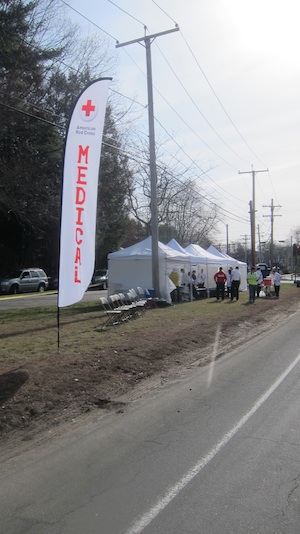
This is First Aid Station 12 looking east towards Chestnut Avenue. Photo Credit: Tim Carter
This is my third season of working public service events using my ham radio skills. I have to tell you that I wasn’t expecting to become a thread in an historical tapestry, but I am now.
I’ve got the photos to prove it, I’ve got one of the much-sought-after yellow and blue 2013 Boston Marathon volunteer wind breakers, and an abundance of personal memories to prove I was part of the tragic historic day.
The Communications Cascade
I’ve been told by many seasoned ham radio operators that the Boston Marathon is the premier public service amateur radio event. It’s the World Series. It’s the Super Bowl.
It’s the World Cup. It’s the Daytona and Indianapolis 500 in one.
I can tell you it’s as challenging a communications amateur radio event as you might ever work. Now that I’ve worked it two years, and that’s a very short time compared to many operators who have worked it for well over twenty years, the Boston Marathon deserves those accolades.
If you like numbers and want to get your head around what’s involved, consider this:
- Linear Marathon – communications spread out over 26 miles
- Nearly 150 amateur radio operators on the course and in Net Control
- Pre-marathon meeting at 7:00 a.m.
- Average time on station for ham operators – 9 hours that could stretch to 11
- Seven primary communication channels, two bus, and misc backup channels
To put this in perspective, I regularly work public service events on Mt. Washington in New Hampshire. It’s a harsh environment with significant radio propagation issues compounded by the concentrated number of commercial radio and television station towers at the summit.
But even though running, bike, and car races claw their way up the 7.2-mile sinuous mountain roadway, we typically will only have 15 – 20 ham operators on a single frequency. We have a backup frequency, but it’s rarely used.
Bedlam Caused By the Bombs
The weather forecast set the stage for an epic day. Sunshine, temperatures in the mid-50s and light wind. I’m not a runner, but I can tell you I’d rather run in that than the record heat of the 2012 Boston Marathon.
During the 2012 Boston Marathon, our first aid station #12 at mile 18.3 tilted at least two times with runners in different stages of distress. I was told that I had the most ambulance calls of any other ham operator at last year’s event. Believe me, I was looking forward to a day with light traffic in our station.
That’s just what we got as the race progressed. Most of the runners had minor leg cramps and blisters. We did have two runners that needed more extensive care. The radio traffic on our frequency was moderate to light.
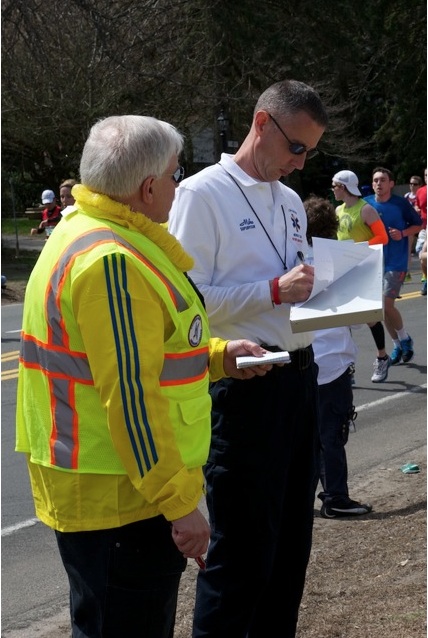
Tim Carter, W3ATB in yellow gear, reporting to station supervisor Mike Tryon. Photo Credit: Don Tryon (C)Copyright 2103 Don Tryon
But just before 3:00 p.m., the rumors started to fly. Keep in mind that the frequency I was on was a mid-course frequency. My job is to just keep my first aid station supervisor, Mike Tryon, in the loop about what’s happening around us.
As Mike said to me earlier in the day, “There’s nice to know and need to know. I just want you to keep me informed with Need to Know.”
Well, a terrorist or two or three made sure that soon enough there would be plenty of Need-to-Know information.
The Pros in Net Control
The ground zero of the entire communications operation is an operations center called net control. A handful of ham radio operators are stationed at net control on radios tuned to specific frequencies. Each frequency covers a portion of the race course.
Think of the race course as a line of linked sausages. Each sausage is a different frequency and net of its own. I was on C5 and the finish line was C7.
Each individual amateur radio operator working at net control has a certain number of water and first-aid stations under his/her control.
The net control operator for the mid-section part of the course I was working was Andrew Maroney, W2AJM. He’s an absolute professional net control operator. His messaging is concise, he’s prompt with replies, and he has a mind like a steel trap.
Understand that his job is to just feed us information that’s critical to us fulfilling our jobs at our assigned locations. Even if he had access to widespread facts about what was happening at ground zero at the finish line, that would be nice-to-know information for those of us farther back from the finish line.
Andrew only dispensed information and facts that the race organizers wanted us to know that were specific to our location and/or it was information to be broadcast to all ham operators. It’s part of the protocol.
As best as I can remember, the first real Need-to-Know transmission from Andrew was the Stop-All-Runners message. At that point, we knew that the rest of the day was going to be anything but ordinary
Unintended Consequences
The race officials only invite qualified runners to participate in the Boston Marathon. This helps maintain the prestige of the event, but it also ensures that 99.9 percent of the people cross the finish line.
At the finish line, the race organizers have all of the runners’ personal belongings, blankets, mylar heat-retention capes, water, an abundance of medical support, wheelchairs, etc.
The first aid stations that are spread out on the course, like the one I was working at, have many of these supplies, but in limited quantities. After all, past marathon records indicate we maybe will see only 50 – 100 runners in our station during the race.
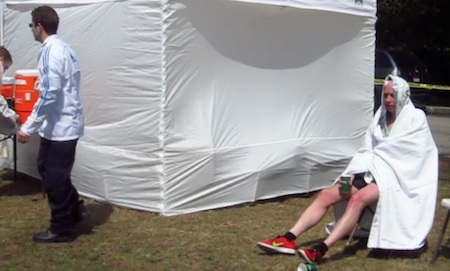
Imagine the nightmare if it was raining and 40 F. Here it was sunny and 54 F, yet the runners that stopped soon got chilled. Photo Credit: Tim Carter
But when the order was given to Stop All Runners, that decision created quite a few unintended consequences. We were very lucky at our station because the vast majority of runners were farther down course. Just a handful of runners and walkers were approaching us after the bombs exploded in downtown Boston.
But further down the course, especially in the last mile or two, thousands of runners were still approaching the finish line. The bombs created a new set of problems:
- How do the runners stay warm?
- How do the runners get fed?
- How do the runners get to their belongings?
- How do the runners discover if their loved ones waiting at the finish are okay?
- How do the runners let their loved ones know where they are?
- How will thousands of runners be transported to who-knows-where?
Plus countless other questions…..
But guess what, that’s where all of our training kicked into high gear.
Cell Phone Dependence
The speculation is that government officials, within minutes of the explosion, shut off the cell towers in downtown Boston. I can’t confirm this. But it sounds like a good idea as bombers discovered years ago that cell phone towers can be hijacked to help them with their sinister and nefarious deeds. Author’s Note: At the time the cell system became overloaded. The circuitry is designed for an 8:1 ratio. As soon as more than 1 in 8 phones starts to make a call, the system starts to get bogged down.
Cell phones are just radios. For years bombers have used cell phones as part of the mechanism to detonate bombs. It’s brilliant when you think about it. The bomber can be 100 feet away or a continent away, make a call to the phone connected to the bomb, and BOOM.
What really is happening? When you call a cell phone and it rings or vibrates, an electrical energy impulse within the phone happens that causes the phone to ring or vibrate. This electrical energy can be used to ignite a bomb fuse. It’s that simple. But don’t try this at home.
Many runners don’t carry cell phones, and they were desperately trying to use anyone’s phone, including mine, to call their loved ones at the finish line.
Everyone was getting a busy signal. That could have happened because the cell networks were overloaded, or because officials turned off the cell towers.
The bottom line is there were several hundred people who were able to continue to communicate during the disaster. Police, fire, and others like me who had radios were still talking.
Keep that in mind. Perhaps this will be the wake-up call to convince you to get your amateur radio license and discover what hundreds of thousands of us already know. We know how to stay connected in disasters and other situations where traditional communications systems suddenly don’t work.
Youthful Enthusiasm
Working at First Aid Station 12 with me was a gifted radio operator, Noah Goldstein, KB1VWZ. Another ham operator was also with us named Shirley Dulcey, KE1L.
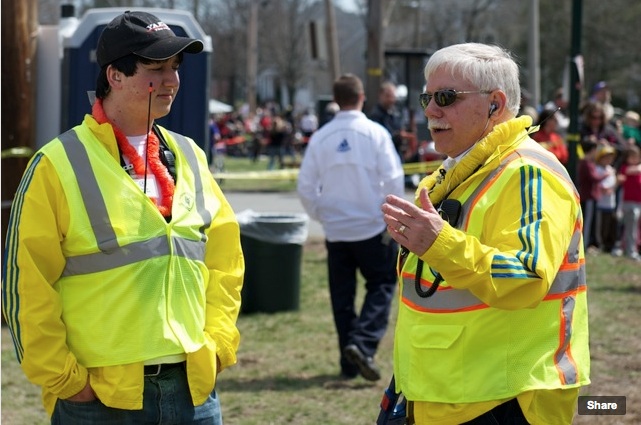
Noah Goldstein, KB1VWZ on the left talking with Tim Carter, W3ATB on the right. Photo Credit: Don Tryon (C) Copyright 2013 Don Tryon
Mike Tyron, at our morning organizational meeting, requested that I stay at the First Aid station all day acting as his connection with the outside world. Noah and Shirley were assigned to the mobile medical teams.
If runners need assistance at any part of the course between our station and the next closest first aid stations either up or down the course, a two-man medical team runs to their aid. A ham radio operator goes with them in case they need to request an ambulance or additional help.
Noah is a young man, I guesstimate to be around 20 years old. He was bursting with energy and enthusiasm. It’s completely understandable because he’s participating in a world-class amateur radio event.
As the anxiety ballooned after the blasts, Noah became restless. Not only was he concerned about a friend at the finish line, but he wanted to also ratchet up his participation as a radio operator.
Twice I had to remind him of the structure of the communications team. It was important for Noah to realize that the leaders at net control knew more than we did about what was going on. They were counting on us to remain on location at our station. We represented known assets at a given location, and if we were to be re-deployed farther down the course to help, net control would make that call, not us
Noah got his wish. Within 90 minutes, he was told to move down the course to First Aid Station 13 which was set up just west of the Newton, MA City Hall. Within a short time, the race organizers moved many of the runners to the city hall building. This got them out of the weather and into a covered building with plenty of chairs and real toilets.
Buses were arriving bringing runners from other locations to Newton City Hall. Noah was stationed at the City Hall building and was finally released at about 6:45 p.m. He did a magnificent job all day, and there’s no doubt it will be a day he never forgets.
The Temptation
Each radio operator in the field has enormous responsibilities. You could have a person’s life in your hands at any time. A runner may be in desperate need of help and the station supervisor may ask you to request an ambulance with advanced life support capabilities.
What does this really mean? It means you MUST be able to communicate. This means you probably should come to the event with two radios.
I had two radios. I could tune to two different frequencies. In fact, each of my Yaesu VX-7R radios is equipped to monitor two separate frequencies at the same time.
I knew the frequency the finish line radio operators were using. I could have brought it up on either of my radios to gather nice-to-know information at any time.
But I didn’t. It would be a distraction. I’m sure I wasn’t alone. My job was to keep Mike informed and listen to my net control operator in case he had a direct message for me or an area-wide message for all operators.
After Action
I’m sure that right now the leaders of the communications team are meeting, or have scheduled a meeting, to discuss what we did right and what we did wrong. Professionally it’s called an after-action report.
I can tell you from my perspective that just about everything went right. Immediately after the bomb blasts, the radio traffic intensified. It continued to ratchet up as new challenges were exposed.
But each time, the race organizers and communications team rose to meet the challenge. On my frequency, and I imagine that used for the finish line, there was never chaos.
The reason was simple. Amateur radio operators that volunteer for the Boston Marathon are anything but amateurs. That moniker just means we’re not paid to perform on the radio. It’s illegal for us to accept compensation if we use amateur radio bands.
I was in the company of nearly 150 professional radio operators that stayed focused, didn’t clog the frequencies with unneeded requests, and they followed established protocols set up years in advance for just this dreaded situation.
To be honest, it was a thing to behold. It’s my hope that all of the communications of the day were recorded for each frequency and that they’re released one day so you can hear what I heard in my earpiece.
I heard calm, focused, and concise radio requests. I heard virtually no frustration. I didn’t hear any screaming. I didn’t hear any frantic requests for supplies.
I’m still recovering mentally from the day. I’m very sad for those three innocent people whose lives were snuffed out by the callous act of the cowards who set down the satchels containing the bombs. My guess is that at least two people were involved, with each person casually setting down the bag and seemingly forgetting to pick it up as he/she walked away. I’m also concerned about all those injured and the collateral damage caused to all those that know the dead and injured.
I can tell you I’d go back tomorrow to work the Boston Marathon again. I’ll be even more vigilant. If you’re a ham radio operator, you should volunteer too. If you’re not an operator, consider becoming one. You can even volunteer to do other tasks non-radio related. I can tell you with confidence that many, if not all, of us will return. The terrorists will not take control of my destiny. No, it’s going to be the other way around.
There will be a new awareness about being able to communicate when cell phones don’t work. I was lucky enough to be one who could communicate clearly, even with someone around the world, when tens of thousands of people couldn’t.
I was lucky enough to be in a position to help many who needed help. That’s why all of us ham radio operators volunteered to be in Boston along with the thousands of other Boston Marathon volunteers.
Believe me, we’ll be back.
Author’s Note:
Hours after this post was published, I participated in a one-hour Skype interview with Gary Pearce, KN4AQ, the founder of HamRadioNow.TV.
I urge you to watch this video to discover more about what happened at the Boston Marathon. You’ll also discover more facts about the operation.
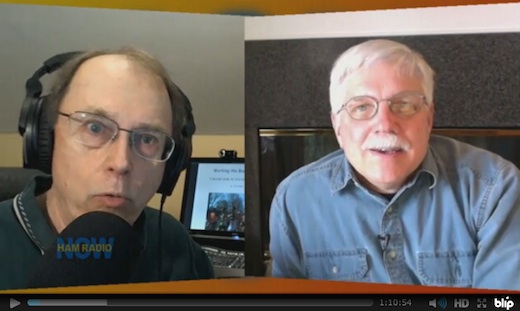
Screenshot of the Gary Pearce and Tim Carter Interview. Copyright (C) 2013 Gary Pearce
Did this blog post help you?
I invest time writing and taping videos to help other hams like you save time and lower their blood pressure. Frequently equipment manuals are lacking key details that cause frustration. I’m trying to fill in those gaps when I can.
If this post saved you some frustration, I’d appreciate it if you’d consider making a simple donation – even just a buck – using the PayPal button below. The more donations I receive, the more time I can devote to helping you.
Thanks in advance.
Author’s Note: Read the note at the top of this story. It appears ten years later I’ve discovered we were all pranked by the government.





